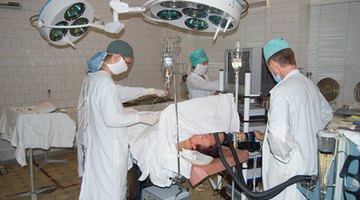Epigastric Hernia Symptoms
A hernia is the protrusion of an organ through the wall of the body cavity that surrounds it. Hernias are common, especially abdominal hernias.
An epigastric hernia involves the protrusion of intestines through the abdominal cavity lining called the peritoneum. Epigastric hernias occur between the bellybutton, called the umbilicus, and the chest. Epigastric hernia symptoms are typically mild unless the intestine or other organ becomes incarcerated, or trapped, in the muscle wall.
Abdominal Bulge
An epigastric hernia may cause a bulge in the abdominal wall when you are exerting yourself.
For example, if you bear down when having a bowel movement or strain to pick something up, you may see the hernia bulge beneath the skin on the abdomen. Dr. James Lee with the University of Maryland Medical Center advises that when you lay down to rest, this prominence or bulging should disappear; if it does not, you should see a doctor.
Pain

Belly Button Hernia Symptoms in Adults
Learn More
Typically epigastric hernia symptoms do not include pain when the hernia is small. But if the hernia enlarges or becomes trapped in the abdominal muscle wall, pain and tenderness over the hernia site will occur. Pain and tenderness associated with an epigastric hernia should be reported to a physician.
Nausea and Vomiting
Nausea and vomiting are atypical symptoms of epigastric hernia. If nausea and vomiting occur along with increasing pain or fever, you should seek immediate medical care. Nausea and vomiting are signs of a serious complication of epigastric hernia.
Fever

Belly Button Discoloration in a Newborn
Learn More
Another epigastric hernia symptom that indicates complications is fever.
You should not develop fever with a simple epigastric hernia. If you do run a fever, see a doctor. Most likely there is a problem with blood flow to the portion of the intestine that is herniated through the peritoneum.
Skin Discoloration
Skin discoloration over the hernia site is a sign of a serious epigastric hernia complication called a strangulated hernia. The authors of “Medical-Surgical Nursing: Critical Thinking for Collaborative Care,” explain that a strangulated hernia can occur when an epigastric hernia becomes incarcerated. This means that if a portion of an organ, such as the intestine, gets trapped in the abdominal muscle wall the blood flow to this part of the organ can be cut off. This causes intense abdominal pain and possibly nausea and vomiting.
The hernia will most likely protrude and be visible on the abdomen. The area might become discolored, appearing blue or black.
A strangulated hernia is a medical emergency.
Treatment involves surgery. If you notice a change in color over your hernia, seek medical care immediately.
Related Articles
- “Medical-Surgical Nursing: Critical Thinking for Collaborative Care”; Donna D. Ignatavicius MS RN, & M. Linda Workman Ph.D.; 2006











